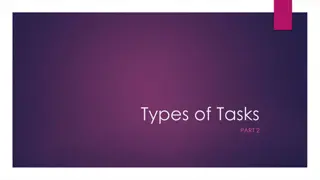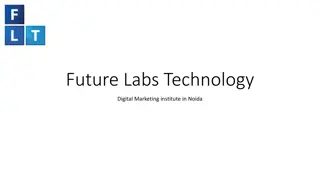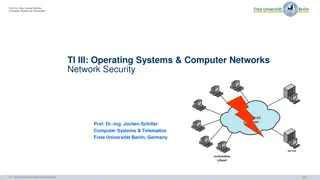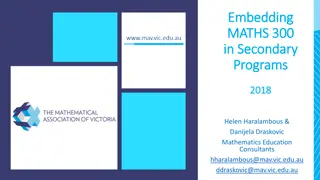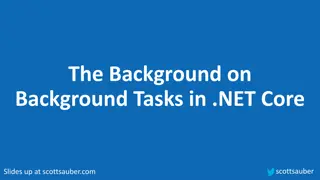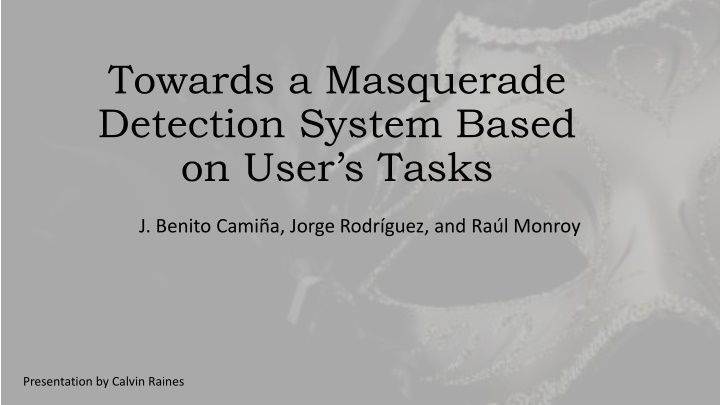
Masquerade Attack Detection Systems and Approaches
Explore masquerade attacks and the detection systems focusing on user tasks, previous approaches, weaknesses in old methods, and new datasets like object-based critical concepts. Learn about WUIL simulations and Windows intruder logs for enhanced security measures.
Download Presentation

Please find below an Image/Link to download the presentation.
The content on the website is provided AS IS for your information and personal use only. It may not be sold, licensed, or shared on other websites without obtaining consent from the author. If you encounter any issues during the download, it is possible that the publisher has removed the file from their server.
You are allowed to download the files provided on this website for personal or commercial use, subject to the condition that they are used lawfully. All files are the property of their respective owners.
The content on the website is provided AS IS for your information and personal use only. It may not be sold, licensed, or shared on other websites without obtaining consent from the author.
E N D
Presentation Transcript
Towards a Masquerade Detection System Based on User s Tasks J. Benito Cami a, Jorge Rodr guez, and Ra l Monroy Presentation by Calvin Raines
What is a masquerade attack? Hello <Your Name Here>
How can masquerades be detected? Audit data Commands I/O devices Search patterns File system navigation
What were some previous approaches? Intrusion detection expert system (IDES) Jack ls cd ls get open open close get get... g++ vi vi get close Jill cd vi vi g++ ./pgm vi ls vi close get open cd ls vi Earliest form of masquerade detection system (MDS) Normal Used audit data Looked at sequences of actions Shonalu et al. (Unix commands) Attack First general MDS test set Logs of user commands broken into chunks
What were some previous approaches? Mouse Angle/speed of movement Click/drag Keyboard Static or Free text RUU (Are You You?) Search patterns; 22 features File access, process creation, browsing, etc.
What weaknesses do the old ways have? Intrusive recording Static keyboard recording discourages new passwords Specificity of results Unix commands specific to OS One versus the others (OVTO) No true attacks in test set RUU simulated attacks, but these were not faithful Data sets are static
What new dataset is used? Critical concept: objects, not actions Which file system objects accessed and how used Directory Graph Navigation System C Access Graph CV PDF Cat 10 8 3 C C C Desktop Misc Desktop Documents Work CV Music Docs Desktop PDF.pdf Funny Cat.gif Temp Work School
What is WUIL? Windows Users and Intruder simulations Logs dataset 20 Windows users normal activity MS Windows audit tool 3 levels of attacks carried out on each user computer Data theft attacks Limited to 5 minute window Carried out by same person
What attacks were simulated? Basic Opportunity Searches My Documents for interesting looking names, opens the file, sends to self via email, and closes file Intermediate Prepared Brings USB to copy files to, uses MS Windows search tool to find files with specific strings (e.g. *password*.*), remove USB and remove tracks Advanced Plotted Uses .bat file to automatically copy files the intermediate attack found
What is task abstraction? Assumption: Files in the same folder are related to each other, and thus using any file in a certain folder can be viewed as working on a task. Supertask Directory Subdirectory A Object 1 Object 3 Task 1 Object 2 Object 4 Task 2 Subdirectory B Task 3 Object 6 Object 5 Object 7
What is task abstraction? Depth Cut Point Deepest level for which >70% of task rate is underneath it < 100 Tasks 3 < DCP < 10
What are the benefits of task abstraction? Less required storage Resilient to change Files added and deleted frequently
What experiments were performed? Testing for: Objects v. Tasks How much information needed to detect attacks? Different percentages of construction/validation Approach: Window based approach (unmixed, size 20) Na ve Bayes and Markov Chains Five-fold cross validation on best const/valid ratio
What is Nave Bayes? Frequency probability Subset squares blue all + - ? 5/8 3/6 7/12 3/8 3/6 5/12 http://sebastianraschka.com/Articles/2014_naive_bayes_1.html
How was Nave Bayes implemented? Symbol fuc a K nu ci Explanation number of times user (u) acceced resource (c) 0 < a << 1 to prevent 0 probabilities Total number of resources Length of u s training set specific resource Calculated Combined Window size n = 20
What are Markov Chains? Sequence probability Sequence SSSCRRRCS SRSRCCCSR Probabilities .5x.5x.4x.5x.6x.6x.3x.4 .1x.1x.1x.3x.1x.1x.4x.1 Total 0.00216 0.00000012 http://techeffigytutorials.blogspot.com/2015/01/markov-chains-explained.html
How were Markov Chains implemented? Consider each day as an independent trace Attack and normal traces separated Determine n-gram size using divergence Divergence largest difference between normal and attack Treat each n-gram within a trace as a state Sum up 1-Probability of each state transition, divide by number of events Penalty: if state transition nonexistent, add 5 If higher than threshold classify as an attack
How were Markov Chains implemented? Day 1 Day 2 Fun School School Fun Fun School School Fun Fun Fun Fun School N-gram size 3 1 1 F FS FSF 0.66 0.5 1 FFS SFF 0.33 - 1 0.5 1 1 S SF SFS
How were Markov Chains implemented? Normal Attack School School Fun School School School Fun Fun School Fun Fun Fun (0.5+0+0+0+0.66+0)/6 (0.5+5+5+5+5+5)/6 0.19 4.25 Sum (1-Pr) / #events Penalty: If Pr = 0, (1-Pr) = 5
What is Mean-Windows-to-First-Alarm? Average amount of windows needed to classify a trace as an attack
What can be concluded? Markov Chain model more accurate Although, slower at detecting strong attacks Task based detection comparable (slightly better) than object based detection



